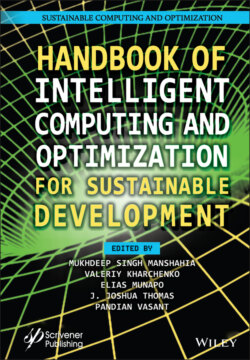Читать книгу Handbook of Intelligent Computing and Optimization for Sustainable Development - Группа авторов - Страница 127
5.3.1.3 Results and Discussion
ОглавлениеIt is customary and vital in ML for performance comparison to have standard benchmarks and open data sets [19]. That is the rule in the computer vision, voice recognition, and other applications in which DL techniques have gained more remarkable success. Similarly, a group of researchers in [7] has generated synthetic and over-the-air (OTA) data sets for modulation classification for conducting reproducible research in wireless communication [19, 7]. Publicly available data set RADIOML 2016.10A (synthetic) are used as a benchmark for training and evaluating the performance of the proposed classifier. The Keras framework was used to design CNN architecture. Network model training, validation, and testing have been carried out on benchmark data set. This data set is a sample, TF I-Q Image with a size of 128 × 128 for CNN, and it contains a total of 368,640 samples. Here, 85% (313,344) of the data samples are used for the training and validation set and the remaining 15% (55,296) are considered for testing purpose. The implementation of training and prediction of the proposed network is carried out in Keras running on top of TensorFlow using Google Colaboratory.
CNN is trained with TF spectral images of STFT with EOC. The classification accuracies achieved by the network, overall, the modulations of the Master data set, and for different values of received SNR levels are plotted in Figure 5.3. It is observed that STFT-CNN combinational module achieved a classification accuracy of 84% compared to the benchmark network of [19] that achieved 75% to 80% at the highest SNR 16 dB. This is because of TF spectral images could capture joint TF energy density, IF, and phase information independently. Classifying accuracy of both DL networks without preprocessing was lacking compared to the joint TF energy density preprocessed image–based networks.
Figure 5.3 Comparison of overall classification accuracy with benchmark network.
Figure 5.4 shows a confusion matrix for the CNN classifier for all the ten classes at 16 dB SNR. At high SNR of 16 dB networks confusion matrix plot depicts the almost clean diagonal with respect to predicted and true labels of 1,000 test data. It is observed that there is slight confusion between AM-DSB and WB-FM, QPSK and 8PSK, and 16 QAM and 64 QAM. This may be due to the short time observation window, and under harsh, noisy condition some features of QAM, PSK, and WB-FM may be matching with low order modulation.
Figure 5.4 Confusion matrix CNN with synthetic data set.
By comparing with the CNN model proposed in [19], proposed models provide better classification accuracy, since the network model is trained with two labels that are SNR and modulation type. The proposed model tries even to estimate the SNR also. It can be observed from the accuracy plot that around 5%–10% enhancement in prediction accuracy even at low SNR.
